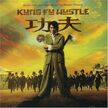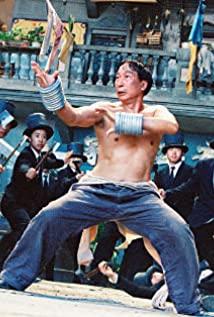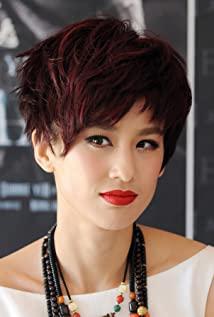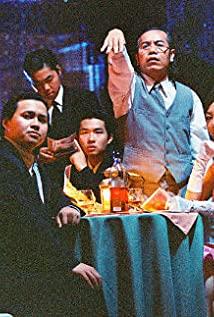How many years, waiting for you to be a major city in the rivers and lakes
- watching kung fu films from Stephen Chow's "Kung Fu" Inheritance
at the end of the movie "Kung Fu", A Xing played by Stephen Chow solved the confrontation with the evil god of fire and cloud with a palm of the Tathagata falling from the sky. He looks like Bruce Lee reincarnated in his shirt. It was once called "Kung Fu" since then, and it has also completed a magical tribute. This is not only a tribute to his idol Bruce Lee by Stephen Chow, but also a tribute to the Chinese movies that were once golden because of Kung Fu movies. Tribute and legacy.
There are two types of kung
fu films, one is martial arts kung fu film, and the other is martial arts kung fu film. In terms of martial arts films, in addition to kung fu films, there are also ghost films and sword films. (Another way of saying that martial arts films and kung fu films are collectively referred to as "martial arts films".)
The name "kung fu film" became familiar to the world in the 1970s. Due to the popularity of Bruce Lee movies, Chinese "kung fu" came into being in the world. considerable impact. But as early as the 1920s and 1930s, the first golden age of Chinese cinema, the filmmakers adapted the influential martial arts novel "Burning the Red Lotus Temple" into a movie, shooting 18 episodes in a row, even leading the fashion. The rise of martial arts kung fu films in Hong Kong is due to the well-known generation of kung fu master Wong Fei-hung, who was born in the late Qing Dynasty and died in the melee of warlords. His daring chivalrous spirit is praised by people. In 1949, Hong Kong director Hu Peng filmed the first film "Huang Feihong whip the wind and extinguish the candle" with the legendary Guangdong folk martial arts character Huang Feihong as the protagonist. In the following 50 years, Huang Feihong became the first famous Chinese martial arts kung fu film. Brand, who has played this role include Guan Dexing, who has played Huang Feihong many times, and later kung fu movie stars Jackie Chan and Jet Li. Among them, the Huang Feihong series directed by Hu Peng and starring Guan Dexing has shot nearly 80 episodes. Throughout the 1950s, there were generally two types of Kung Fu martial arts films in Hong Kong and Taiwan. One was Kung Fu films in the Republic of China like Wong Fei Hung, and the other was martial arts films of gods and monsters. The representative works of the latter included "Tathagata Palm" and other films .
In 1965, the term "Martial Arts Instructor" appeared for the first time in the credits of "Cloud Sea Jade Bow Fate" (director: Zhang Xinyan, starring: Fu Qi, Chen Sisi) filmed by Great Wall Company, which is considered to be the first martial arts film. This is a landmark work, and martial arts guidance has officially become an important part of martial arts films. The director of kung fu martial arts films Zhang Che has positioned Wushu to be in charge of designing martial arts movements and providing professional advice, setting a model for martial arts guidance; Among them, the most well-known master Liu Jialiang is the master of a generation of kung fu master Wong Fei Hung. He has directed dozens of kung fu classics for Shaw Brothers, including "Fang Shiyu and Hong Xiguan", "Lu Acai and Wong Feihong", "Bad Head He", "He" Golang Bagua Stick" and "Shaolin 36 Rooms" and so on.
Since then, the golden age of martial arts films has come.
In 1965, Shaw Brothers boss Run Run Shaw decided to innovate to shoot a new type of martial arts kung fu film. Zhang Che and Hu Jinquan shot the legendary martial arts films "One-Armed Swordsman" and "The Drunk Man" in 1966 respectively. These two films established their important position in the film industry. The two directors have very different styles. Zhang Che's martial arts world is extremely masculine, with realistic martial arts action, direct violence and direct blood flow. It is said that every time he makes a movie, the tomato juice used to make fake blood must be filled with two large gasolines. cylinder. Woo Yusen, who was later criticized as having the reputation of "violent aesthetics", got the true biography of Zhang Che. And Hu Jinquan's films tend to be freehand and are good at creating atmosphere. For example, films such as "Chivalrous Girl" and "Empty Mountain Lingyu" combine traditional Chinese landscape artistic conception with martial arts fighting scenes, which are full of classical situations. Ang Lee's "Crouching Tiger, Hidden Dragon" has a somewhat Hu aesthetic style. Martial arts instructors such as Yuan Heping, Liu Jialiang, Tang Jia, Han Yingjie and others who have cooperated with directors Zhang and Hu have become the hottest martial arts instructors. Another important kung fu director is Luo Wei, Guo Nanhong, Chu Yuan and others.
Chinese martial arts films aroused international influence and attention due to Bruce Lee in the 1970s, but the first Kung Fu film that was officially screened overseas was Shaw Brothers in 1971, directed by Zheng Changhe and starring Luo Lie, "The First Punch in the World". The film was screened at the same time in 1,000 mainstream theaters in the United States, with unprecedented splendor. Indeed, it was Bruce Lee who really made Chinese Kungfu flourish overseas. Bruce Lee's life is like a shooting star, but the four and a half works he left behind: "Tangshan Big Brother", "Jingwumen", "Dragon Crossing the River", "Dragon Fighting and Tiger Fighting" and the unfinished "Death Game", which makes people feel spiritual Excited, the phrase "Tell you, the Chinese are not the sick man of East Asia" aroused the patriotic conscience of countless Chinese people. Until "Raptor Crossing the River", Bruce Lee finally made Chinese Kung Fu famous in the world. Bruce Lee's special skills and acting skills are the spiritual core of the film.
In the late 1970s, kung fu films began to decline, with outdated content and silent masters. Until 1978, Yuan Heping, who had been a martial arts instructor for many years, directed "Snake Shaped Hands" for Siyuan Company, using Jackie Chan as the protagonist. Although the plot of the film was not completely out of the way, it was innovative in the design of martial arts. He added a lot of comedy elements to martial arts, and created a new genre of kung fu films - kung fu comedy films. Jackie Chan gave full play to the Peking Opera North School Kung Fu he learned in Yu Zhanyuan's Peking Opera troupe and became a new idol of kung fu films. After that, "Drunken Fist", which the two collaborated again, became a classic. Liu Jialiang, Sammo Hung and others, who have been behind the scenes, also began to officially direct the film. In 1981, "Shaolin Temple", directed by Zhang Xinyan and filmed in mainland China, all used domestic professional martial arts athletes as roles and martial arts designs, was released. The reason why this film is a milestone in the history of martial arts movies is that it abandoned Hong Kong and Taiwan martial arts. The stunts commonly used in the film, such as hanging wires, trampolines, doubles, and quick splicing, are shot with long shots and no doubles are used. All of them are real kung fu.
In the 1980s, after the Shaolin Kung Fu movie, Tsui Hark retired the "Kung Fu" movies again. In the "Shushan Swordsman" he filmed in 1984, he hired Hollywood stunt producers to create a fantasy world of swordsmen, making the film great. be successful. During the same period, Jackie Chan and Sammo Hung shot a series of modern Kung Fu movies, and added a lot of comedy elements to expand the expression of Kung Fu movies. In the late 1980s and early 1990s, ancient costume martial arts films began to attract people's attention again. Hu Jinquan took the name, "Swordsman" co-directed by Tsui Hark and Cheng Xiaodong, "Once Upon a Time" directed by Tsui Hark, "A Chinese Ghost Story" directed by Cheng Xiaodong, "New Dragon Inn", co-directed by Tsui Hark, Cheng Xiaodong and Li Huimin, became the representative work of martial arts kung fu films in this period. Hong Kong cinema continues to create the myth of kung fu movies.
After the birth, prosperity, and change of kung fu films, they entered Hollywood again, which influenced "The Matrix" to use martial arts instructor Yuan Heping to design a set of kung fu moves for the characters, and then to Quentin Tarantino, who claimed to be obsessed with Chinese kung fu and added kung fu films to the film. factors, and adopted the actor Lau Ka Fai from the early kung fu films as the master of white eyebrows.
And Zhou Xingchi's "Kung Fu" follows Yuan Heping's "Snake Shaped Hands", Liu Jialiang's "God Fight" kung fu comedy, plus Zhou Xingchi's original comedy path, it can be said that "Kung Fu" has both inheritance and Self-styled new round of kung fu films.
The "Kung Fu" in the movie The "Kung Fu" in the Kung Fu movie
is true or false. It is rare for a movie like "Shaolin Temple" to fully display the real Kung Fu. Generally, it is special effects (from the most common steel wire to the current movie special effects) plus A real fistfight. An actor with special skills is naturally the soul of kung fu movies: Needless to say, Bruce Lee, the Jeet Kune Do kung fu he created in the movie back then is extremely powerful and has been passed down to this day. In addition, his leg skills are outstanding, and he is known as "Li Sanjiao". He turned and kicked his feet three times, each time he turned and kicked at a different angle. Which leg could kick in half and then decide whether to strike at a high or low place. It was as fast as lightning. . Even if two or three people were besieged, they would be knocked down by Bruce Lee. Younger kung fu stars such as Jackie Chan and Jet Li are definitely tough. Even Zhou Xingchi has been infatuated with Bruce Lee since he was a child and has practiced kung fu for more than ten years.
But there are indeed many schools of folk Kung Fu in China, such as Wong Fei-hung's Southern School of True Kung Fu, Tai Chi, Mantis and so on. Chinese Kung Fu films have the advantage of penetrating Chinese history and can capture all the evolutions of Chinese Kung Fu's masters, while Hollywood's Chinese Kung Fu is a bit undifferentiated and has empty concepts. Although "Kung Fu" uses a lot of computer stunts, which is an off-topic "Kung Fu", there are indeed many real Kung Fu.
Zhang Che's kung fu films focus on realistic kung fu from boxing to flesh, and Bruce Lee's kung fu is also a real posture. At Hu Jinquan's place, his martial arts scenes focus on the aesthetics of action, each move is not fast, just like dancing, every pose has a sense of beauty. Ang Lee's "Crouching Tiger, Hidden Dragon" has the most shadow of Hu's martial arts films, especially in many martial arts scenes, where the emphasis is on form over reality, and the action aesthetics inherit the characteristics of Hu's films.
And Tsui Hark's martial arts kung fu films pay more attention to scene-based performance. When it came to Zhou Xingchi's "Kung Fu", on the surface, there were bridges such as lion's roar and toad, but it did contain a lot of real kung fu, Golang Bagua stick, Twelve Lu Tan legs, and Hong Jiaquan's great successors. Living in seclusion in the pig cage walled city, these kinds of kung fu really have historical records and folk heritage. "Wulang Bagua Cudgel" comes from the film "Wulang Bagua Cudgel" written, directed and starred by Liu Jialiang, director of the old Shaw Brothers martial arts drama, because Liu Jialiang originally Born in Hongquan Authentic. The owner of the breakfast shop is played by Dong Zhihua, the royal actor of the martial arts director Zhang Che. He is a martial artist who studied Peking Opera. "Goro's Eight Trigrams Stick" is an evolution of the Yang family's marksmanship, so the shop owner Zhanqin Demon Brothers will shake out so many guns earlier. Shi Xingyu, Zhao Zhiling, and Dong Zhihua play the roles of porters, tailors and rolling pins in the film as Shaolin monks, Hongquan masters, and Peking Opera martial artists. All three performed very well. Shi Xingyu's kung fu fell on the character "true", Zhao's kung fu got the character "strength", and Dong got the character "smart". In terms of movements, Zhou Xingchi's vision is to cover the development history of Chinese Kung Fu: at the beginning, it was the real Kung Fu of the hard bridge and the hard horse, represented by the three fighters, and then introduced the style of the gods and monsters martial arts, which showed the performance of the two evil spirits of the piano and the devil. The phantom attack, the final battle, uses a lot of steel wire and CG, and it is completely unpredictable.
With so many real kung fu at the bottom, it's no wonder that the internationally renowned media "Screen" magazine commented on "Kung Fu": "The martial arts film that ends all martial arts films, "Kung Fu" makes "Kill Bill" look like a playground melee."
From "Kung Fu"
, the space of kung fu movies is very important. Whether it is a martial arts hall, an inn, or the wild, it is a deliberately built performance place in kung fu movies. This represents a river and lake, and it is also an important background for the development of Kung Fu fighting. The "Pig Cage Walled City" in the film "Kung Fu" is a typical residential scene in "72 Tenants" in old Shanghai. Stephen Chow also seriously considered the "time" of his Kung Fu film. He believes that most of the Kung Fu films in Hong Kong reflect the times Set in the early 20th century or earlier, there are very few kung fu films of the 1930s and 1940s. And this time seems to be between modern and ancient times, a boundary that spans time and space, so "Kung Fu" takes this period as the background.
Zhou Xingchi has always subverted the traditional hero classics with nonsense, like the American geek Quentin Tarantino, he also likes to combine various styles he loves: for example, the shape of the "pig" in the design of the pig cage wall comes from Zhou Xingchi. Favorite stylized movie "Rhapsody in the Black Shop", and the horror of the massive red blood gushing out before going to the fiery cloud evil spirit comes from the American adaptation of Stephen King's thriller "The Shining", sitting with Liang Xiaolong after opening the iron door. The serenity of reading the newspaper is in contrast. Not to mention the stunts, at the end, the lotus hidden weapon fell from the sky and flew to the street beside A Fang, which is completely a replica of the opening feather in "Forrest Gump". The Qin and Demon Brothers play the piano and exert their strength, and the comedy kung fu movies, especially the skeleton warriors sent out in the last blow, are completely comparable to the undead army in "The Lord of the Rings".
Oriental music is widely used in the film: Zheng music, pipa music, and national symphony music (including "Donghai Fisherman's Song", "General's Order", "Crushing General's Order", "Knife Club Suite", "Heroes Overcome the Dadu River", etc.) , it can be seen that Zhou Xingchi is trying hard to maintain the traditional flavor of the film, so as to match the traditional kung fu.
However, "Kung Fu", which combines all these, is completely in the style of Zhou Xingchi: its personal taste, sincere love for traditional Chinese Kungfu, old Shanghai's peasant film tradition and cartoon nonsensical blending, you can see Zhou Xingchi A kind of success that insists on one's own taste, and finally enlarges his own taste to be universal. As Zhou himself said, the ultimate magic weapon in the movie - the palm of the Tathagata: it is a kind of courage. It's like the absolutely ridiculous and wonderful joke that the dagger stuck in the body becomes a mirror, and it's like being beaten half to death but still holding a small wooden stick and beating the head of the Fire Cloud Evil God to death.
It seems that neither the stunts that cost tens of millions or the real skills are not the key to the success of kung fu films in the new era, but the self confidently expressed in the tradition of love.
January 2005, published in "South Wind Window"
View more about Kung Fu Hustle reviews











